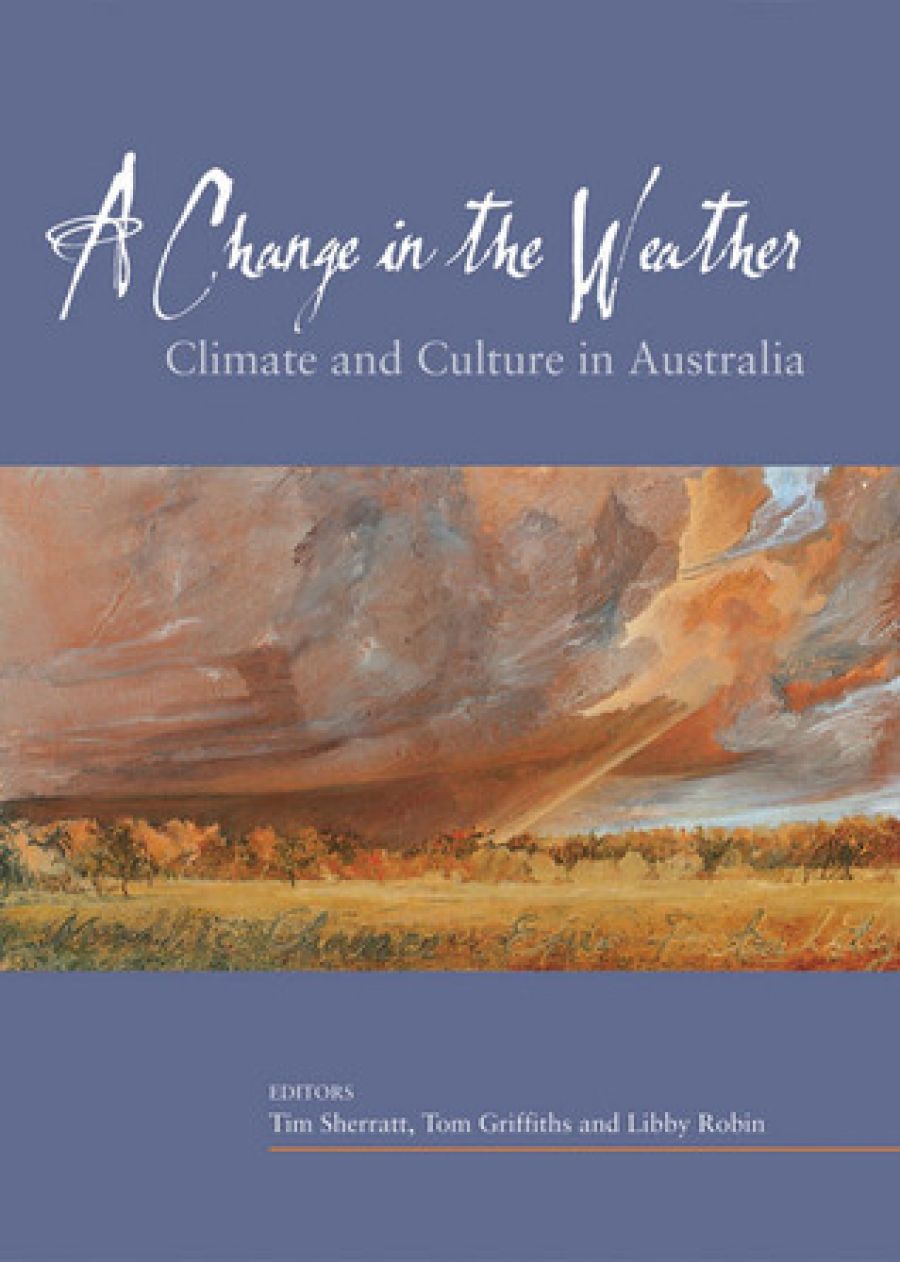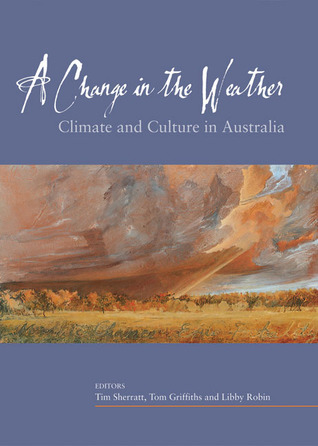
- Free Article: No
- Contents Category: Climate Change
- Review Article: Yes
- Article Title: Should we think like a Banded Stilt?
- Online Only: No
- Custom Highlight Text:
To the west through the windows of my primary school in Terowie, I could see wheat fields, farmed by solid, middle-class farmers who sent their children to the local schools. To the east, if I squinted to the distant hills, I could make out the start of the station country, run by ‘squatters’ who sent their children to private schools in Adelaide. In between, the land was neither one nor the other and the strugglers who farmed it were often obliged to take work in the railways or as labourers on the lands to the east or west. It was all due to Goyder’s Line, I was told. There was always a lurking implication of guilt when Goyder’s Line was mentioned. Anyone who hadn’t the foresight to buy, or inherit, land sufficiently inside or outside the Line probably deserved to struggle.
- Book 1 Title: A Change in the Weather
- Book 1 Subtitle: Climate and culture in Australia
- Book 1 Biblio: National Museum of Australia Press, $49.95 hb, 216 pp
- Book 1 Cover Small (400 x 600):

- Book 1 Cover (800 x 1200):

Culpability and responsibility are a theme running through this collection of sixteen articles deriving from a National Academies Forum held in September 2002. This culpability theme might seem strange given that the most often quoted maxim about the weather is the one falsely attributed to Mark Twain: ‘Everyone talks about the weather but nobody does anything about it.’ But the theme of so many of the chapters in this collection is what we have done, or failed to do, or failed to understand about the weather.
Captain Phillip and his settlers experienced plain bad luck in arriving in Australia in the same year as the severe 1788–95 El Niño event set in. Richard Groves suggests that Phillip, possibly with help from local Aborigines, may have had the insight to realise that the conditions they were experiencing year after year could not represent the sole climate mode and, thus, he persisted in maintaining the colony. Phillip’s struggles were not helped by the loss of the supply ship HMS Guardian in a collision with an iceberg in the roaring forties, described in Tom Griffiths’s chapter on the impact these winds had on the Australian sense of isolation.
But such insights were not the norm. Janet MacCallum traces the fatal effects of a ‘morbid fear of draughts’ that led to excessive wrapping, hot, stuffy rooms and often to heat stroke and dehydration in babies as much as 100 years after first European settlement. Daniel Connell outlines the impact of dry-land agriculture and irrigation on Australian soils and the mistakes arising from misunderstanding the threat posed by millions of years of accumulated salt and compounded by the inappropriateness of English common law on riparian rights: laws that completely failed to deal with anyone wanting to withdraw the quantities of water needed for irrigation and from rivers that lacked reliable seasonal flow patterns.
Janis Sheldrick documents how the profound foresight of George Goyder, South Australia’s Surveyor General in the 1860s, was misunderstood. To many, Goyder’s Line was a line of rainfall and an arbitrary, bureaucratic barrier to the expansion of cereal farming. What Goyder really tried to convey was that his line was a demarcation of the region with rainfall reliable enough for wheat growing from that where variable rainfall made pastoralism the only viable livelihood.
Australia’s approach to our continent’s climate and weather is full of contradictions. Neville Nicholls brings this home in an early contribution to the collection. He points out that professional observers in the first few decades of European settlement identified our climate as one that is ‘irregular’, ‘capricious’ and ‘a tyrant’. He then goes on to document his own struggle to gain recognition that the signs of El Niño could be used as a basis for better weather forecasting. Having gained professional recognition, the Bureau of Meteorology still struggles with how to communicate the forecast to the Australian public in an accurate and meaningful way.
Numerous delightful notions are scattered through the collection. Should we ‘think like a Banded Stilt’, asks Libby Robin in an excellent essay touching upon links between opportunism in Australian bird-breeding patterns and European concepts of migration and nomadism, global economies and international treaties. Should we adopt the ‘pig-headed’ or the ‘view from space’ model of the economy, asks Ian Lowe in his essay on climate change and sustainability. His vision of a sustainable future and respect for natural systems may seem utopian, but so once did the abolition of slavery or a South Africa without apartheid, he reminds us.
The meeting must have been lively in the tea breaks. In different chapters, we have the hypothesis of climate variability leading to the long persistence of hunter-gathering in Australia (climatic determinism, some would sniff). Another asks whether nomadism is the appropriate model for Australia and whether Aborigines were truly nomadic? Deborah Rose rebukes Western culture for either ignoring or attempting to straitjacket Aboriginal knowledge of the interplay of the big forces of the weather into a seasonal calendar. David Walker tackles the curse of the tropics. Does a tropical climate encourage fruit eating, lethargy and despotism, in contrast to the consumption of meat, robust vigour and sound rule of law in more bracing climes? If so, should Australia be considered an Asian landmass, better suited for Asian people, especially the Japanese. Clearly, Walker rejects these notions, which had vogue in the late nineteenth and early twentieth centuries, but he goes on to ask whether we may have swung to an unwarranted defensiveness of the Australian climate and, in particular, of the benefits of the tropics.
The book closes with a series of contributions touching upon climate change. Michael Smith delves into the issues of palaeoclimates and human influences on the landscape, but withdraws with the conclusion that our palaeo-data can reflect trends only over centuries to millennia or longer and, thus, miss the critical responses of human groups within lifetimes. Tony McMichael weaves the story of the interrelations between climate, environment and human health from the time of Hippocrates to the most recent scientific reports on climate change. Clive Hamilton argues that Australia, along with the US, is a culture in denial when it comes to climate change.
There are a few gaps in the collection. Where, for example, are the architects and the links between buildings, climate and culture? Where is the detailed discussion of farmers and their personal relationship with drought and its management? Tim Sherratt touches upon this in his excellent introductory essay, but some discussion would be welcome of the National Drought Policy of the 1990s and its expectation, arising largely from public servants and politicians, that farmers should be held responsible for coping with any drought – other than an exceptional one, whatever that might mean. Although this book is frustrating in that so many themes and ideas are taken up in solo chapters, never to be developed and debated by other voices, it is also a rewarding and fascinating read for that same richness of ideas.
My window now looks out into the opulence of the World Bank building in Washington, and my challenge is how the Bank might use its resources to help people in the poorest nations adapt to climate change. This book is another reminder of the complexities of the interplay between climate and culture. We may develop better forecasts, early warnings of droughts and floods, and new crop varieties that may even be culturally appropriate; but will we still make mistakes equivalent to swaddling our babies in summer, overlooking the threat of rising salt, or failing to think like a Banded Stilt?


Comments powered by CComment